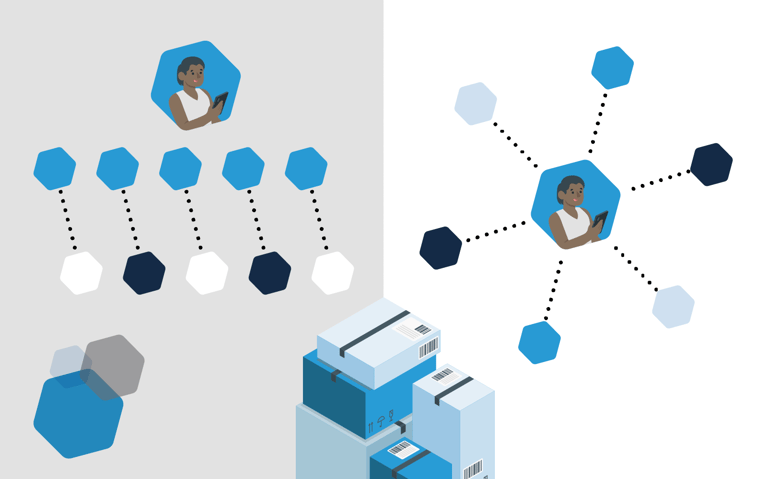Originally posted October 13, 2023, updated May 1, 2024 by A. Wolfe.
Inventory management ensures that the right products are available in the right quantities at the right time. When inventory management is effective, it optimizes cash flow, minimizes stockouts and reduces holding costs associated with excess inventory. However, there are several inventory management strategies – each with pros and cons. Brands must consider their current and future needs to determine the ideal inventory strategy or hybrid approach for their business. But before developing a plan, knowing how each works is essential.
One common approach that’s been around since the 1970s is just-in-time inventory (JIT) management. In manufacturing, it’s known as “lean manufacturing” and emphasizes reducing waste at every production level. For ecommerce sellers, just-in-time inventory management offers significant benefits, but there are also risks. To determine whether JIT will work for you, let’s explore the benefits, potential risks and key components that make JIT work successfully.
What is just-in-time (JIT) inventory management?
Just-in-Time (JIT) inventory management is a strategy aimed at minimizing inventory levels by synchronizing production with customer demand. Unlike traditional inventory methods that involve keeping large stockpiles of goods, JIT focuses on producing goods only as needed in response to customer orders. This approach seeks to eliminate waste associated with excess inventory, reduce carrying costs and improve operational efficiency.
At the core of JIT is the concept of pull-based production, where goods are manufactured in response to actual customer demand rather than forecasted demand. This requires close coordination between suppliers, manufacturers and distributors to ensure that materials and components arrive precisely when needed. By aligning production with demand, JIT helps companies reduce lead times, increase responsiveness to market changes and improve overall flexibility.
However, JIT relies heavily on efficient logistics and supply chain management to ensure that raw materials and components arrive at the production facility exactly when they are needed. This requires robust relationships with reliable suppliers and careful monitoring of inventory levels throughout the supply chain. JIT encourages continuous improvement through practices such as total quality management (TQM) and lean manufacturing principles, aiming to streamline processes and eliminate non-value-added activities.
Benefits of implementing just-in-time inventory management
Brands using just-in-time inventory management can minimize excess inventory and associated carrying costs, optimizing their working capital allocation. By aligning production with actual customer demand, JIT reduces the risk of overstocking or stockouts, enhancing operational efficiency. JIT also encourages leaner processes, providing agility and responsiveness to market changes. Some of the benefits businesses experience with JIT inventory management include:
Cost savings
Just-in-time inventory management primarily saves costs by minimizing inventory holding costs associated with excess stock. Because JIT synchronizes production with demand, it reduces the need for large warehouse spaces and excess inventory storage. This decreases warehousing expenses such as rent, utilities and labor. JIT also helps mitigate the risk of inventory obsolescence or depreciation, as products are produced and sold closer to their actual demand, reducing the likelihood of outdated or unsellable inventory.
JIT streamlines production processes by focusing on efficiency and eliminating waste, resulting in lower production costs. With JIT, companies can optimize their use of resources, including raw materials, labor and machinery, leading to cost savings throughout the supply chain. It allows brands to facilitate tighter supplier relationships and enables volume discounts by letting companies order materials precisely when needed, reducing inventory holding costs and the need for bulk purchasing.
Overall, the cost-saving benefits of JIT extend beyond inventory management into various aspects of operations, contributing to improved profitability and competitiveness for businesses implementing this lean manufacturing strategy.
Improved efficiency and production flow
Implementing a JIT strategy lets you optimize the production schedule within the shop floor, effectively identifying and eliminating bottlenecks. However, to meet evolving demand dynamics, brands must ensure a seamless flow of operations, which requires careful attention to cycle times and production sequences.
When you successfully implement JIT, you have greater flexibility in responding to shifts in customer preferences or market demands without the burden of costs associated with excess inventory. The ability to pivot quickly between production runs lets manufacturers adapt to changing market conditions more efficiently, enhancing overall operational efficiency. For ecommerce retailers, JIT facilitates timely response to emerging trends, allowing swift adjustments to product offerings and the ability to capitalize on emerging market opportunities.
Reduced risk of obsolescence and inventory waste
We’ve all seen times when consumer demand shifted suddenly, leaving dead stock that will likely never sell or excess inventory that must be liquidated. Because you’re developing products or buying inventory much closer to the time it’s needed with JIT methodologies, you reduce the risk of obsolete products or inventory waste.
With JIT, you’re only delivering materials or goods when they’re needed for production or sale. This reduces waste and improves efficiencies. At the same time, it’s easier and less expensive to make changes in your production or product lines. Manufacturers and sellers need to keep a careful eye on inventory levels to avoid running out and being unable to fulfill orders. Keeping adequate safety stock levels is key to making a just-in-time inventory strategy work.
Enhanced supply-chain collaboration and communication
JIT requires close collaboration between suppliers, manufacturers and sellers. Everyone in the supply chain has a part to play in efficient creation, production and fulfillment processes. Deploying just-in-time inventory management fosters stronger relationships. To make it work, you need suppliers that you can depend on for finished products and tight management of demand forecasting, production schedules and inventory levels to make informed decisions and respond to changing market conditions. Fostering these stronger relationships and strategic partnerships encourages mutual trust, laying the groundwork for future collaborations and innovations.
Boost in profitability
JIT inventory management can boost profitability by minimizing inventory levels, reducing carrying costs such as storage, insurance and depreciation, resulting in a higher return on total assets (ROTA) ratio. With lower inventory levels, companies can utilize their cash more efficiently, purchasing only the goods or materials needed immediately, lowering the cost to purchase goods and improving ROTA. JIT also enables businesses to respond swiftly to changes in demand, letting them avoid stockouts and reduce lost sales opportunities. This further contributes to higher profitability by increasing revenue while optimizing asset utilization. Overall, the JIT approach promotes lean operations and resource optimization, leading to improved ROTA and profitability for businesses.
Potential disadvantages of just-in-time inventory
Disruptions to the supply chain can create havoc with JIT, and we’ve seen the ripple effect of such disruptions over the past few years. However, when JIT philosophies are applied properly, the benefits can be great.
However, businesses should also be aware that employing a JIT strategy has potential downsides. If a supplier is unable to deliver the goods you need at the right time, it can affect production for manufacturers and revenue for sellers. Natural disasters, economic uncertainty, shortages and global unrest all influence supply chains. For example, automakers and tech manufacturers have struggled to meet demand due to chip shortages, the pandemic idled production and regulatory and customs transportation delays.
Companies may also be limited in their ability to fulfill large-scale, unexpected orders or take immediate advantage of shifting trends. If you do not have the inventory on hand when an order comes in, you may not be able to move quickly enough. You can mitigate the potential disadvantages by leveraging the right technology and partners. Careful planning, staying close to your customers and building an agile organization makes JIT strategies more effective.
Key components of a successful JIT inventory system
To make a JIT strategy work, you’ll need the following elements:
- Accurate demand forecasting and inventory planning: Your inventory management system is crucial for analyzing historical data, market trends, seasonal demands and customer behavior to predict demand. Leveraging a real-time inventory model enables you to manage inventory turnover and production/procurement schedules. When you connect data across the shopper journey and identify trends more quickly, you gain an advantage and respond more effectively.
- Reliable and efficient supplier partnerships: If you’re depending on just-in-time and a partner can’t deliver, you’re losing money and customers. Establishing tight relationships and long-term partnerships can help ensure a steady supply of materials and reduced lead times. However, even with strong, established relationships, today’s ecommerce sellers are diversifying their supply chains to stay agile. Another option is contract logistics services. While in the past, the option was mainly for freight logistics, today many providers offer contract logistics across the entire supply chain, including network and supply-chain planning, in addition to typical 3PL services like warehousing, order fulfillment and reverse logistics.
- Real-time inventory tracking and monitoring: A real-time inventory management system is crucial to leverage the power of an OMS/WMS to simplify your supply-chain operation, reduce costs and gain greater inventory and order management visibility. Monitoring inventory throughout the supply chain requires tracking mechanisms, such as barcode and radio-frequency identification (RFID) tags, to track movement and stock levels.
Move inventory more efficiently
Just-in-time inventory strategies work best for products that have predictable customer demand. But with the right tools and careful analysis, JIT can be expanded to more inventory categories. You need a robust fulfillment technology solution to mitigate your risk and optimize your inventory management and the right logistics provider to bring it all together.
Whether you plan to adopt a just-in-time inventory strategy or take a just-in-case approach, Cart.com can help you improve and streamline your operations. With a nationwide network of distribution and fulfillment centers, enhanced inventory control and end-to-end logistics capabilities from the shop floor to the front door, Cart.com’s integrated software solutions provides the tech stack you need. Contact our team today to discuss how real-time inventory tracking and monitoring, end-to-end logistics support, unified commerce and omnichannel fulfillment can help grow your business.

-1.webp?width=400)




